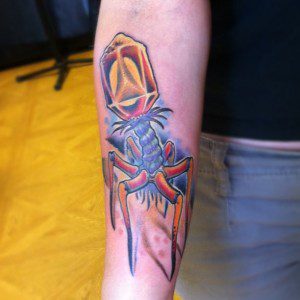

Vincent, Dickson, Rich, and Alan answer listener questions about XMRV, cytomegalovirus, latency, shingles vaccine, myxomavirus and rabbits, and more.
Please help us by taking our listener survey.
Click the arrow above to play, or right-click to download TWiV 165 (61 MB .mp3, 102 minutes).
Subscribe to TWiV (free) in iTunes , by the RSS feed, by email, or listen on your mobile device with the Microbeworld app.
Links for this episode:
- Human CMV incorporates antibody into virions (Cell Host Microbe)
- Probing influenza virion with a supercomputer (Chinese Sci Bull)
- Hallmarks of cancer (Cell)
- Dr. Eric Schadt talk, Mt. Sinai
- Bacteriophage T4 tattoo
- Virology meme
- Sociedad Española de VirologÃa
- Norovirus takes to the skies (Sci Am) and journal article (Clin Inf Dis)
- Propose an ASM General Meeting session
- TWiV on Facebook
- Letters read on TWiV 165
Weekly Science Picks
Dickson – Creation
Rich – America’s Science Decline
Alan – Out of context science
Vincent – The Scientist Top 10 Innovations 2011
Listener Pick of the Week
Jim – Christoph Adami: Finding life we can’t imagine (TED)
Tim – Patient Zero (Radiolab)
Mary – Natural Obsessions by Natalie Angier
Jimmy – Science Exchange
Send your virology questions and comments (email or mp3 file) to twiv@microbe.tv, or call them in to 908-312-0760. You can also post articles that you would like us to discuss at microbeworld.org and tag them with twiv.

She was a fraud, just drop it folks. No need to go pestering the messengers with over the top questions about where they stand.
Who was a fraud?
I had a few comments as I listened to this episode. You discussed Zinc Finger Nuclease (ZFN) technology, and I thought TWIV listeners would love this study:
http://www.ncbi.nlm.nih.gov/pubmed/17965707
Luigi Naldini’s lab used an integrase defective lentiviral vector to express a ZFN and to provide the template DNA used for gene correction. So, they used a virus to provide both the scissors and the patch. This gives highly efficient gene transfer while the integrase deficiency allows transient episomal delivery from a lentivirus, at least in principle.Â
As a stem cell guy, I listened with interest to the portion of the show that discussed pluripotent stem cells. Alan rightfully pointed out that some people dispute whether pluripotent stem cells can make every cell type. For human cells, this is impossible to ethically prove since we cannot make chimeric humans. But for mouse, it has been shown that entire mice can be made from embryonic stem cells (or induced pluripotent stem cells) using a technique called tetraploid complementation.Â
The way this works is that a two-celled embryo is zapped with electricity to fuse both cells together. So your two diploid cells are now one tetraploid cell. This tetraploid cell continues to divide after the fusion and is competent to develop to the blastocyst stage, creating functional extraembryonic tissue. When combined with embryonic stem or induced pluripotent stem cells, the tetraploid cells provide the extraembryonic tissue but will rarely contribute to the embryo itself. Using this assay, it has been shown by many groups that mouse embryonic stem cells and mouse induced pluripotent stem cells can give rise to a mouse that is composed almost entirely from these stem cells.Â
It should be noted that it is almost impossible to prove that 100% of the cells are from the stem cells. And there is data to suggest that not every single cell is derived from the stem cells. But I’d say that, at least where we can do the experiment, there is pretty strong evidence that embryonic stem cells and induced pluripotent stem cells are capable of making nearly every cell in the body.
Our being able to recreate all of those cell types in a dish is another issue entirely. But this experiment, I believe, demonstrates that the potential exists. Our current challenge is to understand the developmental biology required to get to each cell type. We attempt to translate how different pathways are activated and silenced over the course of time from model organisms to a human developmental timeframe. One such success just happened next door to my lab: Lorenz Studer’s group has recently demonstrated the derivation of transplantable midbrain dopamine neurons from human pluripotent stem cells:
http://www.ncbi.nlm.nih.gov/pubmed/22056989
Mark Tomishima, Ph.D.
Head, SKI Stem Cell Research Facility